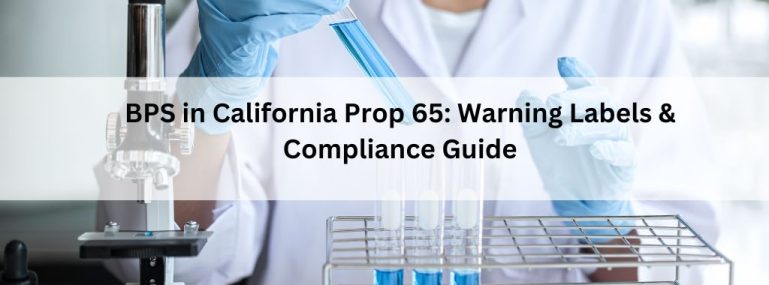California’s Proposition 65 takes a proactive step to enhance consumer safety and highlight potential health hazards by adding Bisphenol S (BPS) to its list of regulated substances. This addition reinforces the state’s commitment to managing chemical exposures and protecting public well-being. Throughout this blog, we’ll explore the ramifications of BPS’s inclusion in Proposition 65, its potential effects on health, and practical approaches for businesses to uphold compliance standards and minimize associated risks.
Bisphenol S (BPS) and Its Uses:
Manufacturers widely use Bisphenol S (BPS) in various consumer goods like plastics, thermal paper, and epoxy resins, even though it’s supposed to be a safer alternative to Bisphenol A (BPA), a known endocrine disruptor with documented health risks. Nonetheless, emerging studies indicate that BPS carries its own set of health risks, primarily due to its potential to interfere with hormone function and reproductive health, prompting a reassessment of its widespread use.
Health Risks Associated with BPS:
Studies show BPS exposure may be linked to a variety of health problems, including:
1. Endocrine Disruption: Like BPA, BPS has been shown to interfere with hormone function, potentially disrupting the endocrine system and affecting reproductive health.
2. Developmental and Reproductive Effects: Animal studies suggest that BPS exposure may impact fatal development and reproductive outcomes, raising concerns about its potential effects on human health, particularly during critical stages of development.
3. Other Health Impacts: Preliminary research has also suggested possible links between BPS exposure and adverse effects on metabolic health, cardiovascular function, and neurological development, though further studies are needed to confirm these associations.
Implications for Proposition 65 Compliance:
BPS being added on California’s Proposition 65 list, businesses must take proactive steps to evaluate and mitigate potential exposures, as failure to adhere to the stringent warning requirements of Proposition 65 could lead to legal Consequences and enforcement actions, emphasizing the critical importance of compliance with regulatory mandates.
Strategies for Compliance and Risk Mitigation:
To ensure compliance with Proposition 65 requirements and mitigate risks associated with BPS exposure, businesses can:
1. Conduct Product Assessments: Evaluate products and materials to determine whether they contain BPS above the established threshold levels.
2. Provide Clear Warnings: If BPS exposures exceed regulatory limits, businesses must provide clear and conspicuous warnings to consumers, employees, and others who may be exposed to their products.
3. Explore Alternatives: Consider alternative materials or formulations that minimize or eliminate the use of BPS in products, where feasible and economically viable.
4. Stay Informed and Engage Experts: Stay abreast of updates to Proposition 65 regulations, consult with legal and regulatory experts, and collaborate with industry peers to share best practices and insights.
Consumer Awareness and Education:
Beyond meeting regulatory obligations, it’s imperative for businesses to place a premium on raising consumer awareness and educating them about the risks associated with BPS exposure. Open communication about product composition, potential dangers, and precautionary measures equips consumers with the knowledge needed to make informed choices and mitigate their exposure to products containing BPS.
The addition of Bisphenol S (BPS) to California’s Proposition 65 regulated substances list underscores the importance of proactive risk management and compliance with regulatory requirements. By understanding the implications of BPS inclusion, businesses can take appropriate measures to assess, mitigate, and communicate potential risks effectively. Through collaboration, innovation, and a commitment to consumer safety, companies can navigate the complexities of Proposition 65 compliance while safeguarding public health and maintaining consumer trust.
FAQ’s:
1. What is Proposition 65, and why was Bisphenol S (BPS) added to its regulated substances list?
Proposition 65, also known as the Safe Drinking Water and Toxic Enforcement Act, requires businesses to provide warnings about significant exposures to chemicals known to cause cancer, birth defects, or other reproductive harm. BPS was added to the list due to its potential health risks.
2. How is Bisphenol S (BPS) commonly used in consumer products?
BPS is frequently used in the production of plastics, thermal paper, epoxy resins, and other consumer goods as a substitute for Bisphenol A (BPA).





